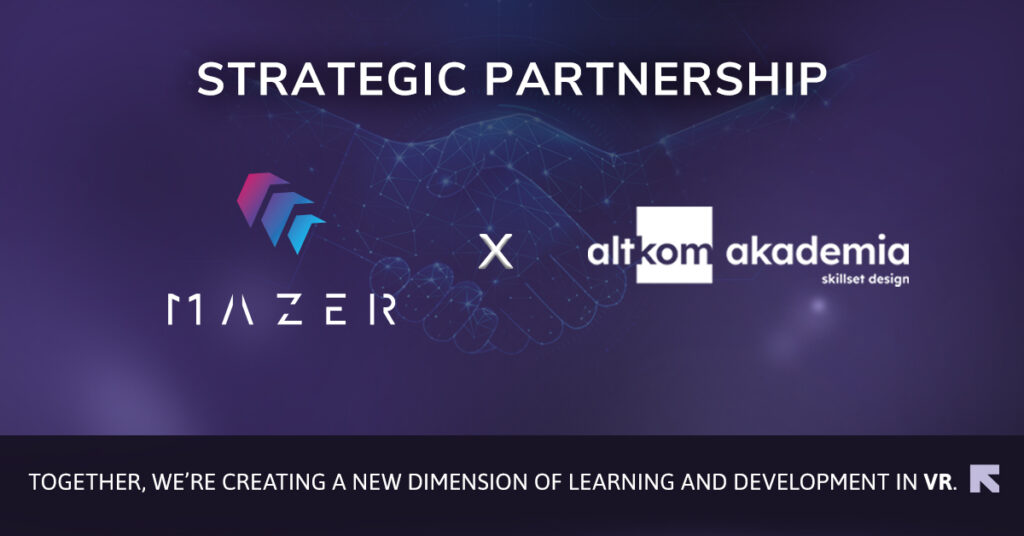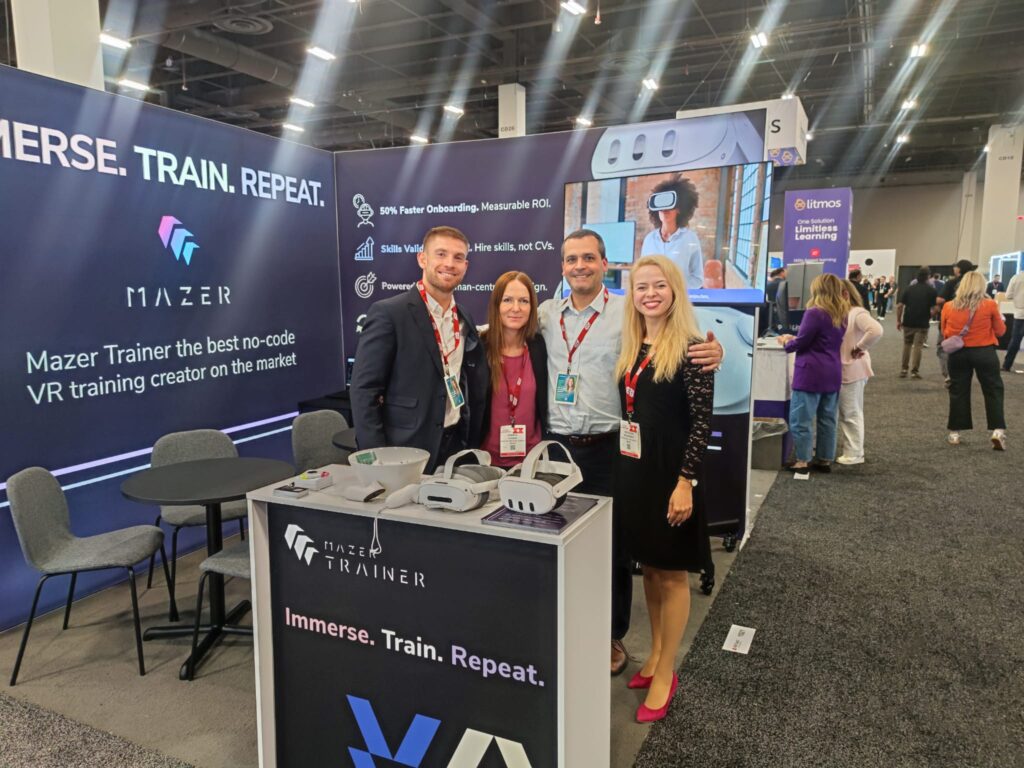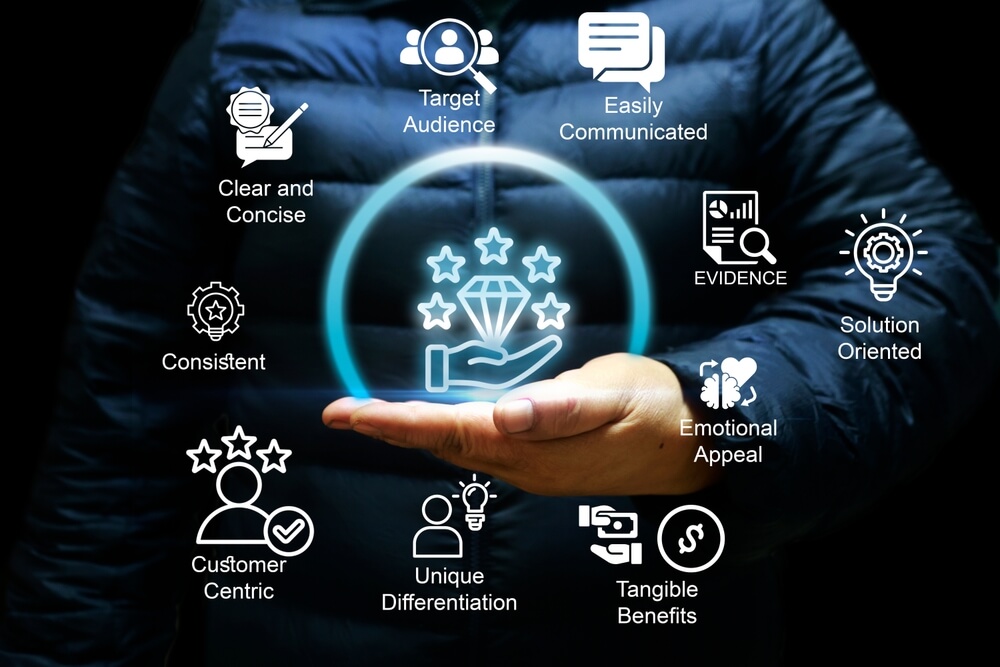5 Ways to Use Generative AI for Immersive Learning
Table of Contents:
Generative AI is transforming education by making training more intelligent and engaging through virtual reality (VR). If your company wants to stay current, you must understand how generative AI works in education. This technology is transforming the way knowledge is delivered and how learners engage with virtual environments, making training more personalized, adaptive, and effective than ever before.
Key Takeaways
- Adaptive learning: Generative AI enables VR scenarios that respond dynamically to learner choices, creating authentic and engaging training experiences.
- Personalized training paths: AI tailors content to individual skills, pace, and preferences, ensuring efficient and relevant learning for each employee.
- Real-time feedback: Learners receive instant guidance and corrections, preventing mistakes from becoming habits and accelerating skill mastery.
- Efficient content creation: AI reduces the effort and cost of developing VR modules by generating immersive, role-specific, and on-demand training content.
- Natural interaction: Voice-activated, AI-driven simulations make VR training feel like a dialogue, boosting engagement and motivation.
- Actionable analytics: Performance metrics and learner behavior insights drive continuous improvement and prove training ROI to stakeholders.
- Future-proof workforce development: Combining AI with VR positions companies at the forefront of innovation, making learning more interactive, scalable, and effective.
How Generative AI Enhances VR Training Content
Generative AI in education can create adaptive virtual reality (VR) content. Unlike static training modules, generative AI applications in VR training enable scenarios to change in real time based on a learner’s actions and decisions. In a negotiation training simulation, generative AI can change the behavior of virtual characters. Dynamic responses create a highly engaging, personalized experience that enhances retention and learning effectiveness.
This adaptability enables companies to deliver training that feels less like a scripted lesson and more like an authentic, interactive session — a key benefit for organizations seeking to enhance employee performance and skills retention through XR solutions.
See also: Creating Immersive and Impactful VR Training Experiences.
Personalized Learning Paths with Generative AI
Every learner is unique, and generative AI can offer personalization that has never been seen before. AI algorithms analyze user behavior, progress, and preferences to create individualized learning paths within VR environments. Each employee gets content tailored to their current skill level and learning style, making training more efficient and relevant.
Personalized VR training also helps companies achieve a higher ROI by focusing on learner-specific needs and reducing the time spent on redundant or irrelevant content.
Real-Time Feedback for Better Learning
Real-time feedback is key to effective training. Generative AI in VR training gives learners real-time assessments that guide them through mistakes and reinforce correct knowledge immediately. This hands-on approach prevents bad habits and builds confidence in new skills.
For corporate training programs, this means faster competency development and more consistent results, as AI tracks progress and adjusts difficulty levels in real-time to keep learners challenged yet supported.
Intelligent Content Creation Makes Training Easier
Traditional training content creation is resource-heavy. Generative AI makes this easier by creating immersive learning modules tailored to various roles, industries, and learning objectives. You can scale your training without compromising quality.
With generative AI in VR training, you can create fresh content on demand — from simulated customer interactions to technical skill drills — all tailored to your workforce. This saves time and keeps your training up to date with industry standards.
Voice-Activated Simulations Engage Learners
Adding natural language interfaces, such as voice commands, takes immersive learning to the next level. With AI-driven speech recognition, learners can interact with VR simulations more naturally. For example, when you say “Show me an example,” the simulation will adapt to provide you with targeted scenarios or explanations.
This conversational interaction makes training feel more like a conversation than a lecture, with more user engagement and exploration in the virtual environment. It’s a new way companies can use AI for immersive learning to boost motivation and knowledge retention.
The Future of Generative AI in Education and XR
The intersection of VR and AI is just the beginning. As this technology advances, companies will see even more advanced and immersive training experiences that combine personalization, real-time adaptation, and intelligent automation. From onboarding to complex skill development, the future of immersive learning will be more interactive, efficient, and scalable than ever.
By investing in generative AI in VR training, innovative companies will be ahead of the curve in education innovation, ready for the changing business landscape.Get in touch to learn more about XR solutions with generative AI today.
What is generative AI in VR training and why does it matter?
Generative AI dynamically creates or adapts VR learning content based on learner inputs and context. It transforms static modules into interactive, personalized experiences that improve engagement, retention, and real-world performance.
How does generative AI make VR scenarios adaptive in real time?
AI models monitor user actions and decisions, then adjust NPC behavior, difficulty, and storyline on the fly. For example, in negotiation training, virtual characters change tone, strategy, or objections based on the learner’s responses.
Can generative AI create personalized learning paths in VR?
Yes. AI analyzes behavior, progress, and preferences to tailor scenarios, pacing, and content difficulty, ensuring each learner practices the right skills at the right time for higher ROI and faster mastery.
How does real-time AI feedback improve learning outcomes in VR?
Generative AI provides instant guidance, corrective prompts, and reinforcement while the learner performs tasks. This prevents bad habits, builds confidence, and accelerates competency development across roles and levels.
Does generative AI reduce the effort of creating VR training content?
Yes. AI can draft scenarios, dialogues, and practice drills tailored to roles and objectives, helping teams refresh or expand libraries quickly without sacrificing quality or relevance.
How do voice-activated, AI-driven simulations enhance engagement?
With speech recognition and conversational agents, learners ask questions or issue commands (“show an example”), and the simulation responds contextually—making training feel like a dialogue, not a lecture.
What metrics can we track with AI-enhanced VR training?
Platforms capture time-on-task, error types, success rates, decision paths, and mastery levels. These analytics support continuous improvement and demonstrate impact to stakeholders.
How should companies start implementing generative AI in VR training?
Begin with high-impact use cases, run a pilot, define success metrics, and build internal champions. Scale by standardizing content templates, governance, and integration with existing L&D systems.
What about data privacy, security, and compliance in AI-driven VR?
Choose solutions that minimize personal data, encrypt sensitive information, and comply with regulations (e.g., GDPR). Clear governance and opt-in transparency build trust while enabling AI-powered personalization.

Author: Rafał Siejca
Rafal has over twenty years of corporate experience, including roles at Millennium Bank, Comarch, and leading software teams at PZU, one of Europe’s largest insurance companies. As one of Poland’s few true VR experts with a decade of experience, he ensures timely, high-quality project delivery as CEO and CTO.










